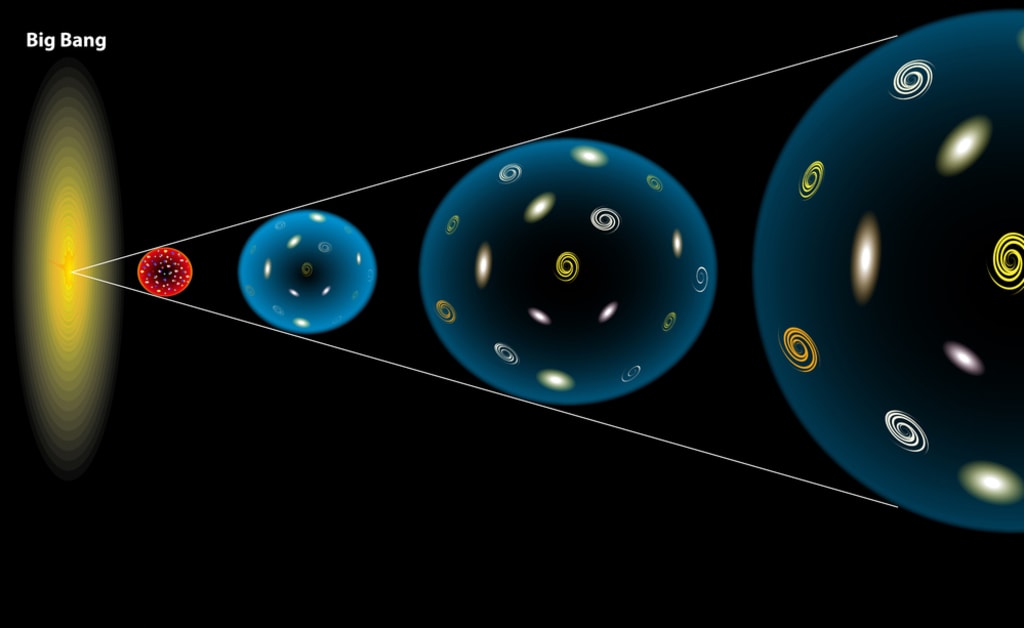EUCLID SPACE TELESCOPE WILL EXPLORE DARK ENERGY
The Euclid Space Telescope’s mission is to explore the composition and evolution of dark energy. Find out how its observations of over a billion galaxies aim to solve what scientists call cosmology’s greatest mystery.

At the start of the 20th century, cosmologists were beginning to think they were quite close to having our universe figured out. Classical physics had explained so much about planets, stars and the galaxy that it seemed only a matter of time until science solved any remaining mysteries.
It hasn’t turned out that way. Since then, astronomers have discovered that there are as many as 2 trillion galaxies outside our own Milky Way.
What’s more, those galaxies are all moving away from us and from one another, meaning that space itself is expanding. This disproved the prevailing steady state model in which the universe had always existed and could neither expand nor contract.
UNIVERSE’S EXPANSION SUGGESTS BEGINNING AT BIG BANG
Instead, the universe’s expansion indicates it must have had a beginning. At the moment the universe began, which we now call the Big Bang, everything must have been very close together and also very hot.
Twenty-five years ago, two teams of researchers were studying the universe’s expansion by observing white dwarf star remnants, what astronomers call Type 1a supernovae. The researchers expected to see the expansion of the universe slowing down because of gravity.
Instead, the team’s findings revealed something far more puzzling. The expansion of the universe is accelerating.
MYSTERIOUS FORCE ACCELERATES UNIVERSE’S EXPANSION
That suggests that some other mysterious energy form drives that acceleration. Scientists call this unexplained force dark energy, and they consider it cosmology’s greatest mystery.
This week, the journal Science profiled the the mission of the European Space Agency’s (ESA’s) new Euclid Space Telescope. Its primary goal is to accurately measure the effect of dark energy with an eye to explaining this enigmatic force.
Cosmologists think of space of a “perfect fluid,” and they measure dark energy’s effect as the ratio of that fluid’s pressure to its energy density, a value they call “w.” Existing research suggests that w has a value close to -1.
EUCLID SPACE TELESCOPE TO SURVEY OVER A BILLION GALAXIES
The Euclid Space Telescope will attempt to survey over a billion galaxies. That involves observing more that one-third of the sky in regions where features of the Milky Way galaxy don’t interfere.
Because the speed of light is fixed, when we look out into space, we also look back in time. This will enable Euclid to see galaxies as they existed more than ten billion years ago.
The primary mirror onboard the Euclid Space Telescope has a 1.2 metre diameter. The light the mirror gathers will support the Euclid Imaging Channel (VIS) and the Euclid Spectroscopic Channel (NISP).
PRIMARY MIRROR SUPPORTS IMAGING AND SPECTROSCOPIC CHANNELS
The VIS instrument will provide data from within light’s visible wavelengths. The NISP will conduct spectroscopy and photometry in near-infrared frequencies.
The data the Euclid Space Telescope’s two instruments collect will include the shapes, redshifts and spectral properties of all those galaxies. The findings will fall into four broad categories.
The large-scale galaxy redshift survey will map the three-dimensional distribution of galaxies across a broad swath of the observable universe. This will give scientists a better grasp of the way galaxies cluster and clump together and how this relates to the effects of dark energy.
MATTER’S DISTRIBUTION AND GROWTH OF COSMIC STRUCTURES
Weak gravitational lensing, or cosmic shear, refers to how gravity from intervening objects influences the light from distant galaxies. The Euclid Space Telescope cosmic shear data will provide additional data on matter’s distribution, the growth of cosmic structures and their relationships with dark energy.
Baryon acoustic oscillations are the remnants of pressure waves in the early universe. These oscillations leave a unique signature on the way matter clusters in deep space. Euclid will measure these wave remnants to calculate the universe’s expansion rate at different points in time, which should clarify how dark energy has affected that expansion.
Redshift space distortions refer to the way the universe’s expansion shifts the light from distant galaxies toward the red end of the spectrum. The Euclid Space Telescope will measure these red shifts more precisely to try to nail down cosmic structures’ growth rates and further explain how dark energy has affected them.
ULTIMATE GOAL – PRECISE VALUE FOR DARK ENERGY’S EFFECT
The ultimate goal of all this research is to arrive at a more precise and accurate value for w, dark energy’s effect. If it turns out that w = -1, it would mean that dark energy’s density is constant, the acceleration of the universe’s expansion is also constant, and it will carry on indefinitely.
That’s a simple, straightforward answer that’s consistent with the current standard model called lambda cold dark matter (Lambda-CDM). However, that probably wouldn’t provide many new clues about what dark energy is or how it works.
If the Euclid Space Telescope’s findings show that w doesn’t equal exactly -1, it would mean that dark energy is more dynamic and variable. That could mean that dark energy is evolving, a property cosmologists call quintessence.
UNDERSTANDING OF UNIVERSE’S ULTIMATE FATE
That in turn, could change our understanding of our universe’s ultimate fate. Instead of continuing to accelerate at an unchanging rate, the acceleration might increase. It also might decrease or oscillate. These more exotic scenarios have many cosmologists rooting for any w value other than -1.
The ESA plans to launch the Euclid Space Telescope in early July, 2023. The current planned launch date is 11:11 local time (15:11 UTC) on Saturday July 1. The back-up launch date would be Sunday July 2 if needed.
ESA Web TV and ESA’s YouTube livestream will both be broadcasting the launch live online. I’m definitely planning to tune in.
AND ANOTHER THING…
If successful, the Euclid Space Telescope will provide another step toward piecing together the new story humanity needs about the universe and our place in it. Exploring dark energy reminds us that the universe is a mysterious, evolving, awe-inspiring entity, just like nature and humanity.
“In 5 years, I hope we’ll have firm evidence that lambda-CDM is broken in some way,” cosmologist Jo Dunkley of Princeton University told Science.
We always have more to learn if we dare to know.
Learn more:
About the Creator
David Morton Rintoul
I'm a freelance writer and commercial blogger, offering stories for those who find meaning in stories about our Universe, Nature and Humanity. We always have more to learn if we Dare to Know.






Comments
There are no comments for this story
Be the first to respond and start the conversation.